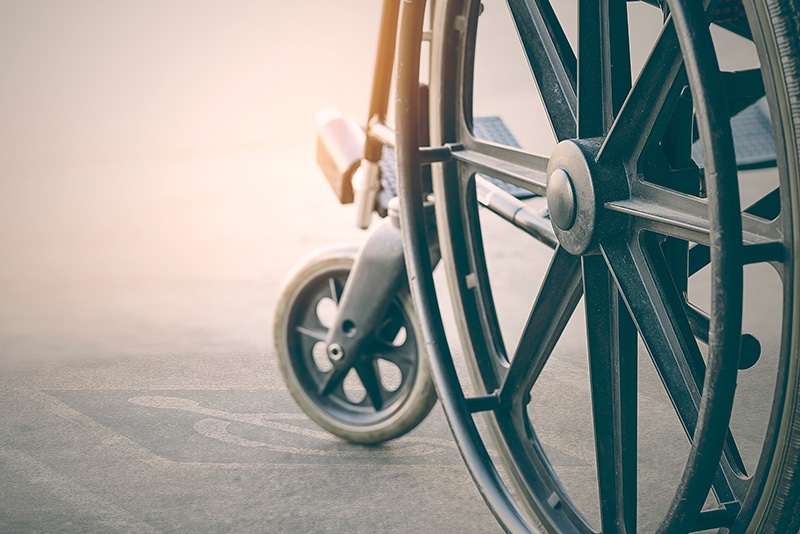Statistics on Disabled Pedestrian Deaths in the United States
Most pedestrian infrastructure is not designed with consideration for disabled pedestrians, resulting in challenges to their safe mobility. As a consequence, there has been an increase in disabled pedestrian fatalities compared to non-disabled pedestrians.
Although specific data solely focused on disabled people is limited, available studies and information shed light on this.
Pedestrian Mortality Among Persons Who Use Wheelchairs
A study conducted in 2015 reported that approximately 528 pedestrians with mobility assistive devices like wheelchairs were killed in traffic collisions in the U.S. between 2006 and 2012. [1]
Pedestrians using wheelchairs face a 36% higher risk of fatal traffic accidents compared to pedestrians on foot. [2]
The risk of death for male pedestrians who use wheelchairs is five percent higher compared to their female counterparts using wheelchairs. [2]
Approximately 47.6% of pedestrian fatal crashes in the United States occur in intersections, with 38.7% of these intersection crashes taking place at locations lacking traffic control devices. Within these intersection crashes, wheelchair users accounted for 47.5% of incidents that occurred in a crosswalk, while 18.3% occurred in areas where no crosswalk was available. [2]

Factors Contributing to the Vulnerability of Disabled Pedestrians
People with disabilities are particularly vulnerable when it comes to road safety due to several factors. There are several factors that contribute to the vulnerability of disabled pedestrians:
- Inadequate Infrastructure: Poorly designed or maintained sidewalks, lack of curb ramps, and inaccessible pedestrian crossings make it difficult for disabled pedestrians to navigate safely. These barriers can increase the risk of accidents and injuries
- Sensory Impairments: Individuals with visual or hearing impairments may have difficulty identifying oncoming vehicles or other hazards, putting them at higher risk when navigating streets and intersections.
- Limited Mobility: People with mobility impairments, such as individuals who use wheelchairs or walkers, may have reduced speed or agility, making it harder for them to move out of harm’s way quickly. This can increase the likelihood of accidents and injuries.
- Lack of Awareness and Education: There is often a lack of public awareness and education regarding the needs and rights of disabled pedestrians. It can result in a lack of understanding and consideration from other road users, further exposing disabled pedestrians to risks.
- Intersection Complexity: Confusing and complex intersections with multiple lanes, turning vehicles, and inadequate traffic signals can be particularly challenging for disabled pedestrians, making it harder for them to cross safely.
- Poor Visibility: Many disabled individuals rely on devices such as wheelchairs or scooters, which can make them less visible to drivers, especially during low-light conditions.
- Insufficient Number of Sidewalks: The lack of sidewalks contributes to the vulnerability of disabled pedestrians. Without sidewalks, disabled individuals are forced to navigate through traffic, putting these vulnerable road users at risk of collision with vehicles.
- Speeding Vehicles: Speeding vehicles pose a serious threat to disabled pedestrians. Since these individuals often have reduced mobility or slower reaction times, it becomes difficult for them to quickly move out of the way of a speeding vehicle. Speeding diminishes the time to react and greatly increases the severity of potential accidents.

Filing Wrongful Death Claims in Cases of Disabled Pedestrian Fatalities
When your loved one, a disabled pedestrian, tragically loses their life due to the negligence or wrongful actions of another party, you may be entitled to file a wrongful death claim.
Here is an overview of the process involved in filing wrongful death claims in cases of disabled pedestrian fatalities:
- Consultation with an Attorney: The first step is to seek legal counsel from an experienced wrongful death attorney. They will guide you through the legal process, assess the viability of the claim, and provide advice on the best course of action.
- Gathering Evidence: The personal injury attorney will work with the family to gather evidence that proves negligence or wrongful conduct on the part of the responsible party. It can include obtaining accident reports, eyewitness testimonies, photos, or videos from the scene, and any relevant medical records.
- Identifying the Responsible Party: It’s crucial to determine who is at fault for the disabled pedestrian’s death. The liable party could be a driver, the local municipality responsible for maintaining safe sidewalks and crossings, or another entity whose negligence contributed to the incident.
- Proving Negligence: To successfully pursue a wrongful death claim, it is necessary to establish that the responsible party owed a duty of care to your disabled pedestrian, breached that duty through negligence or intentional actions, and that this breach directly caused your loved one’s death.
- Quantifying Damages: The next step is to determine the appropriate compensation to seek in the claim. It can include economic damages such as medical expenses, funeral costs, and lost future income) as well as non-economic damages such as pain and suffering, loss of companionship, and emotional distress.
- Initiating the Legal Process: The attorney will draft and file a wrongful death lawsuit on behalf of the family members. The lawsuit will outline the allegations of negligence, the damages sought, and the supporting evidence.
- Negotiation or Trial: Following the filing of the lawsuit, there may be a period of negotiation between the attorneys representing each side to reach a settlement. If a fair agreement cannot be reached, the case may proceed to trial, where a judge or jury will determine the outcome and any awarded damages.
Statute of Limitations for Filing Wrongful Death Claims in The U.S.
The Statute of Limitations for filing wrongful death claims in the United States varies by state. Each state has its own specific time limit within which a wrongful death claim must be filed. Most of the states in the U.S. follow a two-year time limit from the date of the individual’s death. However, consult with a personal injury lawyer nearest to you to file the wrongful death lawsuit in a timely manner.

Compensation Available in Wrongful Death Claims for Your Loved One, a Disabled Pedestrian
When your loved one, who is a disabled pedestrian, tragically loses their life, pursuing a wrongful death claim can provide compensation. The compensation available in wrongful death claims aims to alleviate the financial burden placed on the surviving family members.
In wrongful death claims, compensation can be sought for various losses and damages suffered by you due to the death of your loved ones. These may include financial losses related to medical bills, funeral expenses, and loss of financial support provided by the disabled pedestrian. Compensation can also be sought for non-economic damages such as the loss of companionship, guidance, and emotional support that the loved one provided to their family members.
Consult with an injury attorney specializing in personal injury and wrongful death claims to assess the specific circumstances and determine the potential amount of compensation that can be pursued.
Speak with Goldberg & Loren’s wrongful death lawyers if you have been affected by a pedestrian death involving a person with a disability.
Frequently Asked Questions (FAQs)
Sources:
[1] Stabile, N. C. (2015, November 20). Majority of Car-Pedestrian Deaths Happen to Those in Wheelchairs, Often at Intersections – Georgetown University Medical Center. Georgetown University Medical Center. https://gumc.georgetown.edu/news-release/majority-of-car-pedestrian-deaths-happen-to-those-in-wheelchairs-often-at-intersections/
[2] Kraemer, J. D., & Benton, C. S. (2015). Disparities in road crash mortality among pedestrians using wheelchairs in the USA: results of a capture–recapture analysis. BMJ Open, 5(11), e008396. https://doi.org/10.1136/bmjopen-2015-008396
[3] ADA Tool Kit: Curb Ramps and Pedestrian Crossings Under Title II of the ADA. (n.d.). https://archive.ada.gov/pcatoolkit/chap6toolkit.htm

